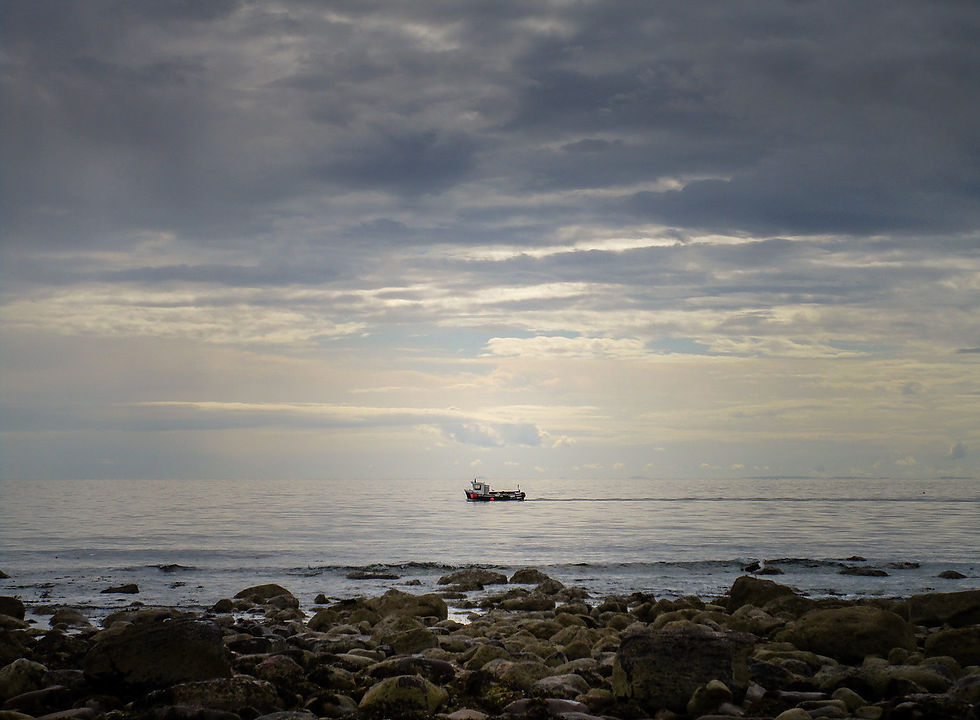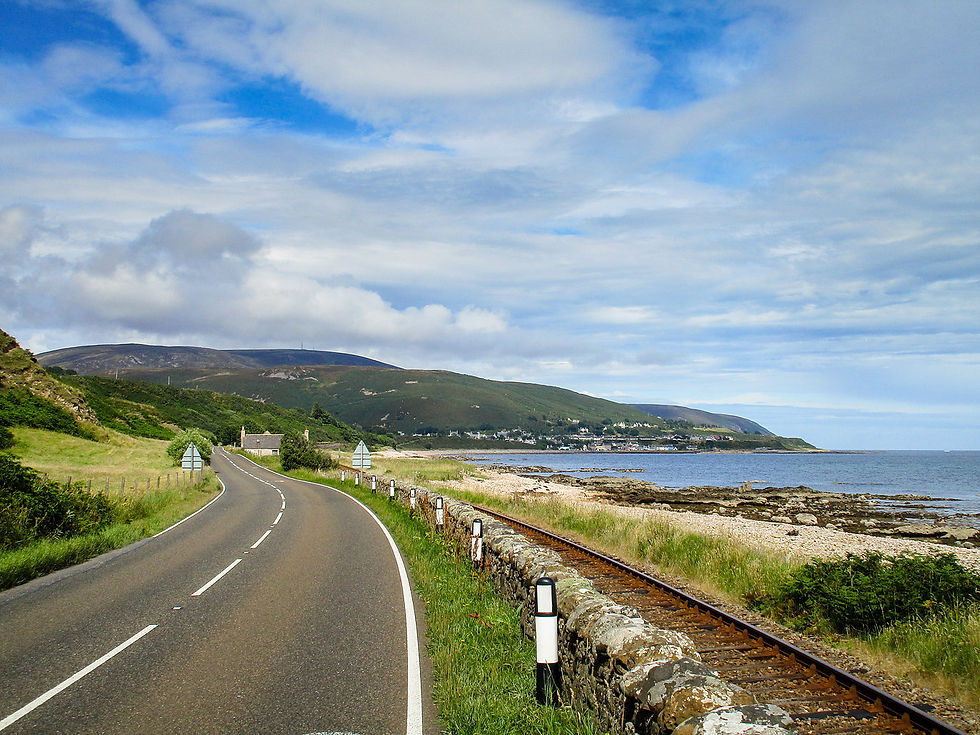Golspie to Helmsdale
- Dave
- Jul 11, 2019
- 6 min read
Updated: Jan 27, 2020
John o'Groats Trail - Day 4 - 20.2 miles - 'Fishing'
The day starts well.
My B&B owner asks if I’m walking LeJog in my uni summer holidays.
I can’t work out whether she’s missed the area of multiplying grey above or whether she’s fishing for a five star Trip Adviser review.
I opt for neither. LeJog is clearly reversing the ageing process, one blistery mile at a time. That's my story and I'm sticking with it.


After spending hours considering route options for my last few days of LeJog I finally decided on a pick’n’mix of both the road and John o'Groats Trail; use the A9 if I need to clock up a few easy miles and the Trail as and when the route looks easy enough or the scenery seems too good to miss.
Today I spent 90% of my time on the Trail, only missing off the final northward meander to Gartymore because I could see Helmsdale from the A9 and it had been a long and often rough day – albeit one filled with engagement, enjoyment and an unsurpassed bounty of wildlife.




It is so quiet as I leave Golspie.
Besides a single dog walker out for an early morning stroll it is just me in the seaside meadows under a sky the texture of marble: veined gold and pinks and liquid greys.
The sea is quiet too, less movement even than yesterday – tiny ripples pealing along the pebbles.
I'm soaking up the peace when the path winds through a laurel archway into a grassy glade where rabbits spring for cover and – suddenly above – parapets and turrets tower above a forbidden forest of pines.
This is Dunrobin Castle, real-life fairytale palace and family seat of the Earl of Sutherland. Featuring 189 rooms, Dunrobin is not only the largest residence in the Highlands, but also one of the longest inhabited houses in Britain, its distinctive chateau-style design the work of Palace of Westminster architect Sir Charles Barry.





Any walk that finds a magical castle in the first 20 minutes is doing something right. And it was to first in a series of captivating moments.
Within minutes of losing the castle over the horizon there is movement on the beach just 20 feet ahead.
A seal. And then another.
I stop and watch them for a while then continue around the next headland where there are plaintive cries in the brine air. I scan the shoreline for movement then realise that what I thought were partly submerged rocks are dozens of grey seals, sunbasking between the high and low waterline.
They are calling to each other in sad, lilting music. It's these haunting calls that have given seals their reputation among sailors; just north of here selkies were said to live as seals in the sea but shed their skin to become human on land.
From then on the walk is a seashore safari.
Around every headland there's more wildlife. Seals – by the dozen – but also herons standing guard at the water's edge, cormorants and shags spreading wings in small flocks, oyster catchers and terns making for the air as they see my approach. And unlike yesterday, I have it all to myself.



Part of the reason for the bounty of wildlife has to be the fact that barely anyone makes the effort to get here.
And the reason so few attempt the walk is it's not plain sailing.
The miles clocked up along beaches are easy enough. But when the sands disappear you're either forced to negotiate the stoney foreshore, where speed is reduced to a judicious, sometimes exasperating, plod, or you head up to the narrow stretch of dune alongs the railway line where the thigh deep marron grass is so dense you can't see the uneven rocks below. I'm giving it my best shot when an adder scares the life out of me uncoiling from the undergrowth and slithering – mercifully quickly – into a trailside thicket.
Thankfully the tougher sections – liberally waymarked with JoG Trail white paint – never last for too long before new sandbanks give easier passage. But the waterline seaweed suggests I'm lucky: at high tide your options would be more limited.
Even so, in the company of such an abundance of wildlife it would be churlish to complain; the rewards far outweigh the effort.





I don't stay long in delightful Brora.
Like much of the coast around here the village is dominated by the legacy of the first Duke of Sutherland. He built the harbour to serve his coalmine and brickworks. And his wife established the village's brewery to discourage locals from distilling their own moonshine whiskey that had 'nursed the people in deceit and vice'.
The first Duke was notable for the role he played in the Highland Clearences – when thousands of crofters were forced from their homes and farms in one of the country's shabbiest land grabs.
Even so, shortly after his death a subscription to pay for a monument in his memory drew donations from far and wide. His 100 foot statue – which had been on the horizon for all of yesterday's walk – still dominates the Sutherland skyline. A fitting, if uncomfortable, testament to his life's work.
I grab a flapjack and eat it alongside James Braid's famous Links then head onto Brora's pristine sands, where I take off my boots and paddle along the surf.
A couple of miles down, for the second time today, there are cows on the beach.
This is not something I've come across anywhere else and wonder if it's some kind of Sutherland farming thing.
They've got calves with them and on a beach there's not much in the way of shelter. If they head my way what do I do? Paddle deeper? Do cows swim?
As it is they simply wander down to the waterline, use the sea as a toilet and then bounce back along the beach to the meadows above, as if they're enjoying the seaside as much as the holidaymakers by the village.
It's all slightly surreal, though I'm not convinced dumping raw sewage directly into the sea is the best thing for Brora's blue flag status.



Onwards along the coast. Sometimes the going's easy. Sometimes it's tough. There are points when paths – and even tracks – can be found, like through the strange caravan graveyard/campsite south of Crackaig. Equally, there are plenty of points when the only sign others been before you are the white daubed waymarks, or a few bent pieces of grass.
Despite never being far from either the A9 or the railway the walk has an air of wilderness adventure. There are banks to scramble, burns to ford and wildlife all around you. Just as my walk on the wild side comes to an end there's one last send off: a herd of red deer running across the brackened links below.








Just short of West Garty I follow Westgarty Burn to the A9 and continue on that into Portgower then Helmsdale.
Sure, it's not much fun, but I've had a ball of a day and I'm keen to press on. To that end most sections of the road have a grass verge to escape upon. And even when there's nothing between you and the crash barrier the road's not as busy as it could be.
So with stinging feet I pick up the pace and head on to my second fishing village of the day, my overnight stopping point of lovely Helmsdale.




My B&B for the night isn’t the best.
I walk into an empty bar. On a beautiful sunny Tuesday. In one of the north east coast’s loveliest villages.
They're doing something wrong.
After a few minutes the landlord comes in.
He is a man of few words.
I’m booked in for tonight I tell him.
He finds my name and asks me to pay up front. It’s only happened a handful of times during LeJog and I instantly hate any place that demands it. Either they don’t trust you or they’re used to guests doing runners. Neither bodes well.
He shows me to the breakfast room. It’s an upstairs box-room kitchen with cornflakes and porridge oats boxes on the worktop. “We find people prefer doing their own thing”, he says.
Right.
“You walking?” he continues.
"Yes."
“North to south?”
“No. I’m heading north. I’m nearly done.”
“It’s not over 'til it’s over,” he replies.
The landlord whose pint glass is half empty.
Though he’s right of course.


Getting a meal in Helmsdale proves to be as difficult as it was in Golspie.
The options are as follows:
The Belgrave – this only serves food to residents.
The Bannockburn Inn – where I’m staying. It is not serving food.
La Mirage – is closed. There is no indication if it closed just for tonight or forever,
And the fish and chip shop.
Now I appreciate these little coastal villages – with their small fishing fleets – probably serve world class fish. And I wish them well. But the veggie alternative is – yet again – a battered veg burger, which I will not eat unless there's really no other choice.
So I go to the Co-op thinking I might as well take advantage of my B&B's eccentric self-serve kitchen facilities and get some fresh fruit and veg.
There are two aisles.
One has confectionary and crisps.
The other has soft drinks, alcohol and tinned foods.
A fridge has a few sandwiches.
I look in vain for a salad box, or some fresh fruit – anything with some nutrition. And without resorting to crude national stereotyping, I think I can safely say that unless they’re regulars on the Ocado organic home delivery route, the good folk of Helmsdale are probably happy enough with the offerings in their only shop and the chippie.
But this turns out to have an unlikely benefit for me.
Just as I’m about to leave I pass a fridge I missed earlier full of cut-price sale items – the stuff that’s not shifting.
It’s a banquet of fresh, nutritious veggie loveliness. There’s a microwavable Malaysian curry; there are salad bags and bananas and cherry tomatoes.
I return to my B&B past the 20-strong chippy queue with as close to a spring in my step as a man who's walked 1,200 miles can muster and eat fresh food for what feels like the first time in weeks.

Back to John o'Groats Trail
Continue the walk: Day 5 - Helmsdale to Dunbeath



Comments